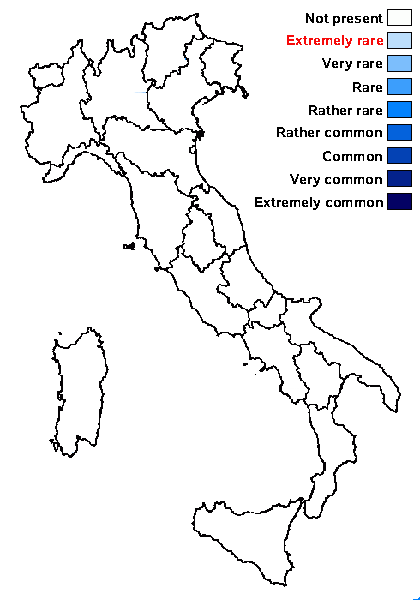Polyblastia cruciseptata Breuss
Österr. Z. Pilzk., 31: 101, 2024
Synonyms:
Distribution:
Description: Thallus crustose, fully endosubstratic, not differing in colour from the rocks. Perithecia black, fully immersed in pits of the rock, globose, without an involucrellum. Exciple 0.15-0.25 mm in diam., brown, c. 25 μm thick, apically black; interascal filaments lacking; periphysoids 20-25 μm long, simple or sparingly branched. Asci 8-spored, clavate, K/I-, fissitunicate, the wall thickened above, with an ocular chamber, dehiscent by extrusion of an endotunica to form a delicate nostrum, 45-55 x 17-22 μm. Ascospores submuriform, with mostly oblique, often cruciform septation, hyaline, very broadly ellipsoid to subglobose, thin-walled, (9-)10-14(-15) x (8-)9-12 μm, 3-6-celled in median optical view, without a distinct perispore. Photobiont chlorococcoid. Spot tests: K-, C-, KC-, P-. Chemistry: without lichen substances.
Note: this caalcicolouss species, characterized by the absence of an involucrellum, the fully endolithic thallus and the subglobose, small ascospores with cruciform septa, was recently described from the alpine belt of the Triglav National Park in Slovenia, not far from the Italian border (see Breuss 2024). It should be looked for in the Italian Alps.
Growth form: Crustose endolithic
Substrata: rocks
Photobiont: green algae other than Trentepohlia
Reproductive strategy: mainly sexual

Predictive model

O. Breuss - Source: Österr. Z. Pilzk., 31: 101, 2024
Slovenia, Gorenjska region, Julian Alps, Kranjska Gora, the mountain trail from Vršič pass to Slemenova špica, around pass Vratca, 1730–1807 m s. m., 9549/3 (coordinates pass Vratca 1807 m: 46.441218, 13.742270), 16. September 2023, leg. O. BREUSS no. 35.688
Growth form: Crustose endolithic
Substrata: rocks
Photobiont: green algae other than Trentepohlia
Reproductive strategy: mainly sexual

Predictive model


